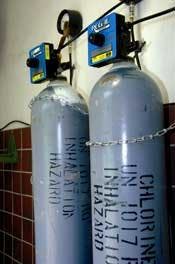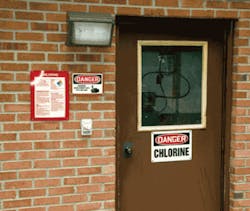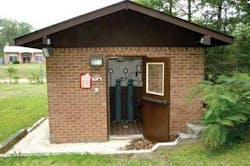Against the Flow: Water Utility Switches to Chlorine Gas
by Gerald F. Connell
Chesapeake Ranch Estates was established in 1960 on the western shores of the Chesapeake Bay about an hour's drive to Washington, D.C., or Baltimore. Since there was no readily available water, a privately owned water system was built to serve the development. By 1979 the community had grown to several thousand subscribers and the Chesapeake Ranch Water Association (CRWA), a not-for-profit cooperative, was founded. The water system has been operated by the cooperative for nearly 30 years.
By 2008, the water system supplied almost 10,000 people through 4,000 connections serving homes and businesses while providing fire protection for the development. Two elevated storage tanks with a combined storage of 750,000 gallons and 70 miles of distribution lines are served by four wells operating at depths in the range of 600 feet. The system is operated by five employees.
The quality of the aquifer required only the addition of a disinfectant to meet Maryland state guidelines. The CRWA system strove to maintain 1 mg/L (ppm) residual level to meet these requirements. The disinfectant chosen was sodium hypochlorite (hypo). The water was pumped from the wells to distribution and storage with hypo added with positive displacement, chemical feed pumps. Dosages of approximately 2 mg/L (ppm) were sufficient to provide the desired system residual. Hypo was supplied in bulk by truck for off loading to CRWA tanks. The 12% strength solution was transferred from 1500 gallon plastic containers on stake bed trucks to both the on-site feed and storage tanks at each well site.
Operation Change
For over 30 years CRWA functioned using the hypochlorite feed system for disinfection. In the 1990s, a new General Manager, George Hanson, arrived. His previous experience had been with regional rural water systems in North Dakota. One of his first actions was to evaluate the system and its operations and plan an improvement program where needed.
The CRWA hypo system operation required a great deal of maintenance and service. Chemical feed pumps required frequent cleaning of check valves, plus gasket and diaphragm replacement. In addition, the chemical cost for hypo was as much as three times greater than chlorine gas. Hanson saw the need to simplify the disinfection operation and therefore recommended that the hypochlorite system be replaced by chlorine gas.
This recommendation ran counter to the general trend in the industry. Resistance was met from all sides but mostly from the operating personnel. The perception that chlorine gas is more dangerous than hypo was a major obstacle to the conversion. Acceptance of the change required the staff's understanding and cooperation. The utility started the process by explaining the differences between the two disinfectants from their chemical and physical properties to methods of handling and feeding. Questions were asked and answered. Eventually, the operating personnel agreed to try the use of gas.
All the four well sites now operate with chlorine gas as the source of the disinfectant. Each disinfectant room uses a set of scales to weigh the chlorine cylinders. The 150 pound chlorine cylinders are mounted on each scale and provide an indication of the amount of chlorine consumed. Spare cylinders are stored in the same room. The total amount of chlorine on-site at any time is less than 500 pounds (one cylinder in use, one full cylinder on standby and two replacement cylinders).
There is no concern about providing heat since Hanson's experience from the Dakota operation showed the ability to feed chlorine gas even during sub-zero weather. Continuous chlorine feed rates of 10 Pounds per Day (200 gr/hr) are attainable with direct cylinder mounted chlorine gas feeders under sub-zero weather conditions. The need for summertime air conditioning of the room is not necessary since the strength of the chlorine is constant at 100% strength. Changing chlorine containers is required on a one or two week basis.
Results
CRWA has been using chlorine gas for over eight years now. The once reluctant operating personnel have become chlorine gas advocates. Since the switchover, one minor leak has developed at a container connection. It was quickly rectified and caused no damage or injury. Training helped staff understand what to do with chlorine containers if future leaks occur. Additional safety systems, such as automatic shutoff systems that would close the cylinders if a leak were detected by the gas detector, could be considered.
About the Author:
Gerald Connell is a consultant with over 40 years experience in the handling chlorine and in the treatment of water with chlorine. He has authored two books (The Chlorination/Chloramination Handbook (AWWA) and The Chlorination/Dechlorination Handbook (WEF)) in the use of chlorine in water treatment.
Chlorine Safety: Perception Vs. Reality
In recent years there has been a great deal of pressure from engineers, regulators, elected officials, the general public and environmentalists to have the water industry move away from chlorine gas to bulk delivered or on-site generated sodium hypochlorite. The perception that chlorine gas is unsafe has been in the forefront of public awareness since the 1980s. This perception has been stoked by recent newspaper headlines relating to explosive devices strapped to chlorine containers in Iraq.
For years it has been common to see headlines proclaim a "chlorine leak", "chlorine gas" or "chemical explosion." The implication being that chlorine gas caused these events. The Chlorine Gas Disinfection Association analyzed the incidents reported in the news media in the late 1900s and early 2000s where words similar to those appeared in headlines. The analysis of these incidents showed that between 60 and 65% of the chlorine release incidents that occurred were hypochlorite (calcium hypochlorite and sodium hypochlorite) based.
All forms of chlorine may create dangerous conditions. This includes the on-site generation of chlorine. Several incidents have been reported of explosions at on-site generator installations. Calcium hypochlorite can have chlorine gas releases and can be a potential fire hazard. Sodium hypochlorite can release chlorine gas from mixing with other chemicals (acids and alkalis) and from heat.
CGDA data shows that there are more incidents of injury at water plants from hypo exposure than chlorine gas – in part because operating personnel have easy access to hypo and have a tendency to treat it with less respect than chlorine gas. Also, chlorine gas in a metal cylinder is less accessible to operating personnel and thus has a built-in safety factor.



